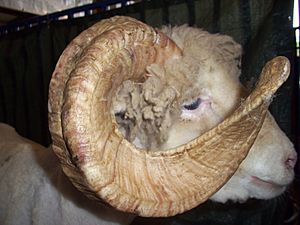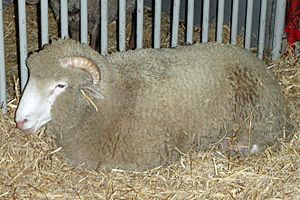Dorset Horn facts for kids

At the Maryland Sheep and Wool Festival in 2010
|
|
| Conservation status |
|
|---|---|
| Country of origin | United Kingdom |
| Distribution |
|
| Standard | Dorset Horn and Poll Dorset Sheep Breeders' Association |
| Traits | |
| Weight |
|
| Wool colour | white |
| Face colour | white |
| Horn status | horned in both sexes |
|
|
The Dorset Horn is a special type of domestic sheep from Britain. It's known for its cool horns! These sheep have been around since the 1600s.
They are very good at having lambs, sometimes even twice a year. What's super unique is they can have babies even in winter. Most other British sheep can't do that!
Contents
History of the Dorset Horn Sheep
Where Did They Come From?
The Dorset Horn sheep first appeared in a place called Dorset in south-west England. They might have come from mixing Merino sheep, brought from Spain, with local sheep. These local sheep looked a bit like the Portland sheep we see today.
Unlike many other British sheep, the Dorset Horn wasn't mixed with breeds like the Leicester Longwool or Southdown sheep. These other breeds were often used to create new types of sheep a long time ago.
In 1891, people who raised Dorset Horn sheep created a special group called the Dorset Horn Sheep Breeders' Association. They started keeping a record book for the breed the next year.
Spreading Around the World
Dorset Horn sheep became popular and were sent to many countries. They arrived in places like Australia, South Africa, and the United States in the 1860s. Many more were brought to the U.S. around 1880.
They reached Australia in 1895 and New Zealand in 1897. This shows how much people liked these unique sheep!
Horns or No Horns?
Later, a new type of Dorset sheep was created in Australia. This one didn't have horns! It was called the Poll Dorset. "Poll" means without horns. This new type was made by mixing Dorset Horns with other hornless sheep breeds like the Corriedale and Ryeland.
Around 1950, the Poll Dorset came to the United Kingdom. It quickly became more popular than the horned version. In 1981, the original sheep group even changed its name to include both types: the Dorset Horn and Poll Dorset Sheep Breeder's Association.
In the United States, a hornless Dorset also appeared. This happened because a lamb was born without horns by chance. This "polled" Dorset was registered in 1956. Soon, it also became more common than the original horned sheep there.
Are They Safe?
In 2007, a big organization called the Food and Agriculture Organization (FAO) said the Dorset Horn was "not at risk" worldwide. This means there were enough of them.
However, in some countries, they are still considered rare. For example, in Australia, they are "vulnerable." In New Zealand, they are a "priority" breed to protect. In the USA, they are "threatened."
In the United Kingdom, where they started, the Rare Breeds Survival Trust lists them as "at risk." This means there are only between 900 and 1500 of these sheep left in the UK. It's important to help protect them!
The Dorset Horn has also helped create other sheep breeds. These include the Dorper and Dormer breeds in South Africa, and the British Milksheep in the United Kingdom.
What Do They Look Like?
The Dorset Horn sheep has white wool and a white face. Its nose is a special pink color. Both male and female Dorset Horns have horns. The male sheep (rams) have big, spiraled horns.
Their wool is thick. Each sheep can produce about 2.25 to 3 kilograms (around 5 to 6.6 pounds) of wool. The wool fibers are about 80 to 100 millimeters long.


